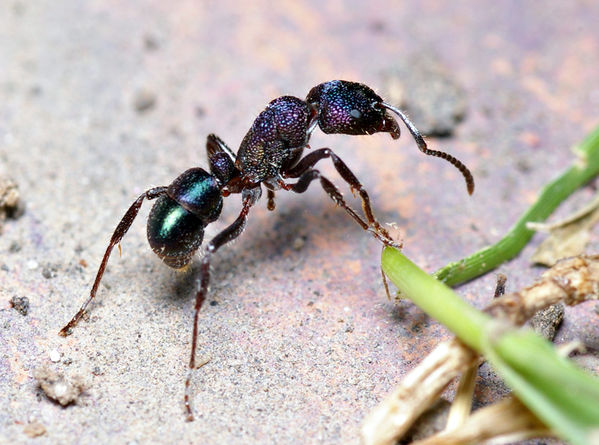
Formidable predators ... a meat ant takes on a cane toad.
---------------
AGGRESSIVE Australian meat ants could become foot soldiers in a war against cane toads. Sydney scientists have discovered that the toxic toads are much more vulnerable to being killed and eaten by the ants than native frogs are, a weakness it may be possible to exploit to reduce alien toad numbers without affecting native species.
Worker meat ants are about a centimetre long with powerful mouth parts, said Rick Shine of the University of Sydney. "They're formidable predators if you're a little toad." Unlike native frogs, cane toads are active during the day, when meat ants roam about scavenging for food. Toads also tend to breed in ponds that are out in the open sun, which results in their young emerging onto bare, baked mud areas, a habitat where meat ants like to forage, Professor Shine's team found. "There is very little living there. All you see is toads and ants."
By making cane toads and seven types of frogs hop along a runway as well as face the fierce ants in the laboratory, the researchers found the foreign toads had some startling shortcomings. Confronted with an approaching meat ant, the wily Australian frogs hopped away quickly, often retreating to the safety of water. However, the foreign toads, introduced to Queensland from South America in 1935 to control cane beetles, sometimes even moved towards the ant, and only took small hops to escape. They also tended to become frozen stiff if seized by an ant.
<snip>
"It is looking encouraging." But this would only be considered if the scientists were convinced there would be no "collateral damage" to native species, he said.
More:
http://www.smh.com.au/world/science/mad-as-a-meat-ant-new-weapon-against-cane-toads-20090330-9h1d.html-----------
Australia has some nasty (and primitive) ants. Basically ground dwelling wasps. The common greenhead

looks pretty much like a harmless North American carpenter ant

.
However, if you roust them while digging around in the garden wearing crocs or thongs- they'll crawl over and sting your feet- like a yellow jacket.